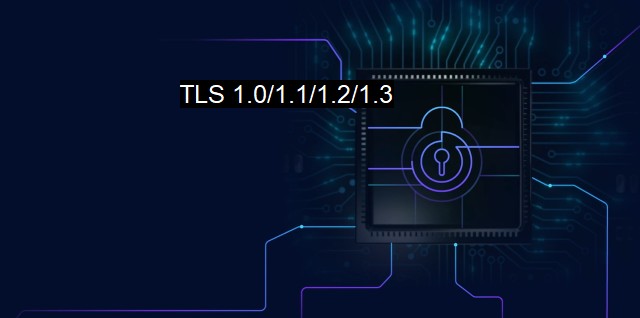What is TLS 1.0/1.1/1.2/1.3?
The Evolution of TLS: Understanding the Differences Between Versions 1.0 through 1.3 to Bolster Cybersecurity
Transport Layer Security, or TLS, is a vital protocol in modern cybersecurity. Cryptographic protocols like TLS provide secure communication over a network. TLS's particular function is to provide data confidentiality and data integrity between two communicating applications. This fundamental concept underpins the functionality of a vast range of everyday internet activities from browsing and emailing to online banking.Version 1.0 of TLS was introduced in the late 90's. Despite its age, it is still widely applied in present-day systems. Nonetheless, it has inherent weaknesses which are a potential concern for providers of various services. Notably, a flaw that often crops up is a specific vulnerability to CBC (Cipher Block Chaining) attacks. By exploiting this vulnerability in the 1.0 protocol, attackers can retrieve the plain text encryption key hidden within encrypted web traffic.
The response to the weaknesses present in TLS 1.0 was the development of TLS 1.1. This version endeavored to address the concerns of its predecessor by incorporating a per-record Initialization Vector (IV) to dodge the CBC vulnerabilities discussed earlier. Although it wasn't a massive leap from the first installment, it was suitable for use while technology advanced around it.
Following along the jigsaw that was cybersecurity during the early 21st century, TLS 1.2 became a significant player. For the first time, it allowed server and client to choose a hashing algorithm. Many consider this much-needed upgrade as sufficient for most of today's cybersecurity requirements. Notable improvements in TLS 1.2 revolved around the ability to select stronger encryption cipher suites, a flexibility that the previous versions did not have.
Despite all those changes, the Internet Engineering Task Force (IETF) eventually released a draft for TLS 1.3. This newly minted version removed outdated cryptography options, integrated the ECDHE for forward secrecy, and shook up the way that the "handshake" between servers and clients was undertaken. Part of the appeal of version 1.3 lies in its commitment to speeding up the previously described processes, leading to faster and more secure connections overall.
Many have hailed version 1.3 as a significant jump in the drive for a fully secured networked society. This comes on the back of its leaner structure (as compared to TLS 1.2), resistance to downgrade attacks, and an inbuilt requirement for perfect forward secrecy (PFS) that protects past communications—even if the future session keys are compromised. Notably, it retires the older encryption cipher suites deemed unsafe, taking into the fold only those authenticated and approved by continuous monitoring processes that have revolutionized cybersecurity measures worldwide.
In questioning what TLS 1.0_1.1_1.2_1.3 is, one finds the very backbone to safer, more secure formation of online communication. Cybersecurity measures and antivirus protection need this support structure to function as intended. TLS aims to ensure that transmitted information, ranging from personal banking data to business contracts and even classified documents, stay secure within the internet ecosystem. By allowing different iterations, each more capable than the last, TLS helps to stay one step ahead of potential attackers and safeguards our technological society's collective well-being. As the world becomes increasingly network-based, the absolute necessity for advanced security measures such as TLS becomes vitally essential. By comprehending TLS’s intricate workings and consistent evolution, one comes to discern how intricate the realm of cybersecurity can essentially be.

TLS 1.0/1.1/1.2/1.3 FAQs
What is TLS and why is it important for cybersecurity?
TLS (Transport Layer Security) is a protocol that provides secure communication over the internet. It encrypts the data that is transferred between two systems, ensuring that it cannot be intercepted or tampered with by a third party. TLS is important for cybersecurity because it helps protect sensitive data from being compromised by hackers or cybercriminals.What is the difference between TLS 1.0, 1.1, 1.2, and 1.3?
TLS 1.0 was released in 1999 and has several security vulnerabilities that can be exploited by attackers. TLS 1.1 was released in 2006 to address some of these vulnerabilities, but it still has some security flaws. TLS 1.2, released in 2008, offers stronger security features, including support for more secure algorithms and better resistance to attacks. TLS 1.3, released in 2018, is the latest and most secure version of TLS, offering increased speed, improved privacy, and stronger encryption.Why is it important to update to TLS 1.2 or 1.3?
It's important to update to TLS 1.2 or 1.3 because older versions of TLS, such as TLS 1.0 and 1.1, have known security vulnerabilities that can be exploited by cybercriminals. By upgrading to a newer version of TLS, you can ensure that your system is protected against these vulnerabilities and reduce the risk of a security breach.Do antivirus programs protect against TLS vulnerabilities?
While antivirus programs can provide some protection against cyber threats, they do not provide protection against TLS vulnerabilities specifically. It's important to keep your system up-to-date with the latest TLS version, as well as to implement other security measures, such as firewalls and intrusion detection systems, to ensure the highest level of protection against cyber attacks.| | A | | | B | | | C | | | D | | | E | | | F | | | G | | | H | | | I | | | J | | | K | | | L | | | M | |
| | N | | | O | | | P | | | Q | | | R | | | S | | | T | | | U | | | V | | | W | | | X | | | Y | | | Z | |
| | 1 | | | 2 | | | 3 | | | 4 | | | 7 | | | 8 | | |||||||